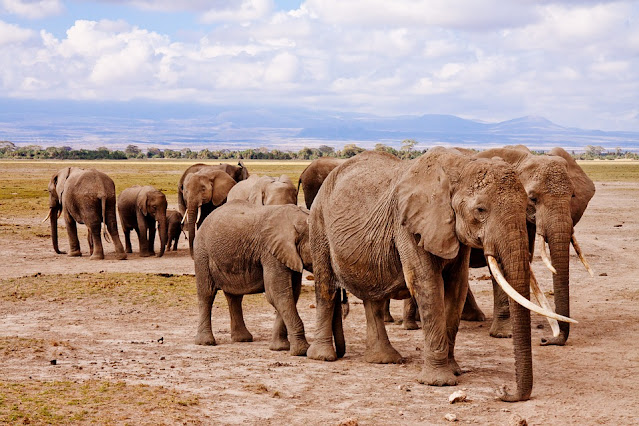Large Mammals || Scientific FS

Large Mammals
What are large mammals?
Large mammals are among the biggest and heaviest living beings found anywhere in the world. They maintain a constant body temperature of 90-104 F, irrespective of the environmental temperature. Elephants, bears, primates, big cats, kangaroos, farm animals, etc. are large land mammals. Whales and dolphins are large marine mammals.
Which are the largest mammals on Earth?
The largest mammal on Earth is the blue whale. It is also the largest known animal that ever lived on Earth. It can grow up to 110 ft (33m) or more in length, with a weight of around 190 tons. Its tongue can be heavier than an African elephant. About 100 people can fit in its mouth at a time. Its heart alone weighs over 900kg and a human can crawl through its major arteries. It is also the loudest animal on Earth, with its whistling call reaching up to 188 decibels, and heard for hundreds of miles.
Which is the largest land mammal living today?
The African elephant is the largest land mammal living today. It can grow up to 100 feet (3m) tall at the shoulder and weigh roughly 6 tons (5400 kg). Both males and females have tusks (large, pointed ivory teeth) and wrinkled, gray-brown skin that is almost hairless.
What are marine mammals?
Marine mammals, which includes seals, whales, dolphins, and walruses, from a diverse group of 128 species that rely on the ocean for their existence. The level of dependence on the marine environment for existence varies considerably with species. For existence varies considerably with species. For example, dolphins and whales are completely dependent on the marine environment for all stages of their life, whereas seals feed in the ocean, but breed on land. Marine mammals can be subdivided into four recognized groups; cetaceans (whales, dolphins, and porpoises), pinnipeds (seals, sea lions, and walruses), sirenians (manatees and dugongs), and fissipeds, which are the group of carnivores with separate digits (the polar bear, and two species of otter). Both cetaceans and sirenians are fully aquatic and therefore are ocean dwellers. Pinnipeds are semi-aquatic; they spend the majority of their time in the water but need to return to land for important activities such as mating, breeding, and molting.
How do camels adapt to the desert climate?
Camels rarely sweat, even in desert temperatures that reach 120 F (49 C), and conserve fluids for longer periods. When camels drink, they soak up water like a sponge. A very thirsty animal can drink 30 gallons of water in only 13 minutes. The hump of a camel can store up to 80 pounds of fat, which a camel can break down into water and energy, in case of emergencies. Nostrils of a camel close to keep sand at bay, and also they have bushy eyebrows and two rows of long eyelashes to protect their eyes. Large, tough lips of camels enable them to pick at dry and thorny desert vegetation.
Where are bears found?
Bears are found in all types of environments, from tropical rainforests to the icy-cold polar regions. The grizzly bear, also known as the brown bear, can stand 7 feet tall and weigh more than 800 pounds. The polar bear is the world's largest land carnivore. A boar weighs around 350-680 kg, while a sow is about half that size.
What are primates?
Primates are distinguished by having hands with opposable thumbs, which allows them to grasp objects and prehensile feet. With the exception of humans, who inhabit every continent, most primates live in tropical or subtropical regions of the Americas, Africa, and Asia. Some common primates are lemurs, chimpanzees, gorillas, orangutans, bushbabies, tarsiers, monkeys, and apes. Gorillas are the largest primates.
What do large mammals eat?
To maintain a high temperature, large mammals require a lot of energy and therefore need a nutritious and plentiful diet. Cats, dogs, tigers, lions, and wolves are carnivores - feeding on meat; deer, cows, elephants, and the giant panda are herbivores - feeding on plants; while bears, pigs, and apes are omnivores - eating both, meat and plants.
How do land mammals move?
Land mammals have four legs and walk by lifting one foot at a time or by trotting. Kangaroos hop and use their tail for balancing. The elephants' feet are so soft and spongy and spread their weight out so well that they barely even leave footprints when they walk. Mammals having an even number of functional toes on each foot are called even-toed ungulates(hoofed animals). Pig, hippopotamus, camel, deer, giraffe, sheep, goat, and cattle are even-toed. odd-toed ungulates include horse, zebra, ass, tapir, and rhinoceros. The giraffe, an African even-toed ungulate, is the tallest animal in the world. Males may be 16-18 feet tall and weigh up to 2000 pounds.
Dolphins are closely related to whales. They are among the most intelligent animals, and very friendly and playful with humans.
Hippopotamuses give birth and breastfeed underwater, despite the fact that almost all their predators live in the water.
Post a Comment